Park' N' Ride in South East Queensland's Transport System Report 2022
VerifiedAdded on 2022/09/15
|14
|3179
|16
AI Summary
Contribute Materials
Your contribution can guide someone’s learning journey. Share your
documents today.
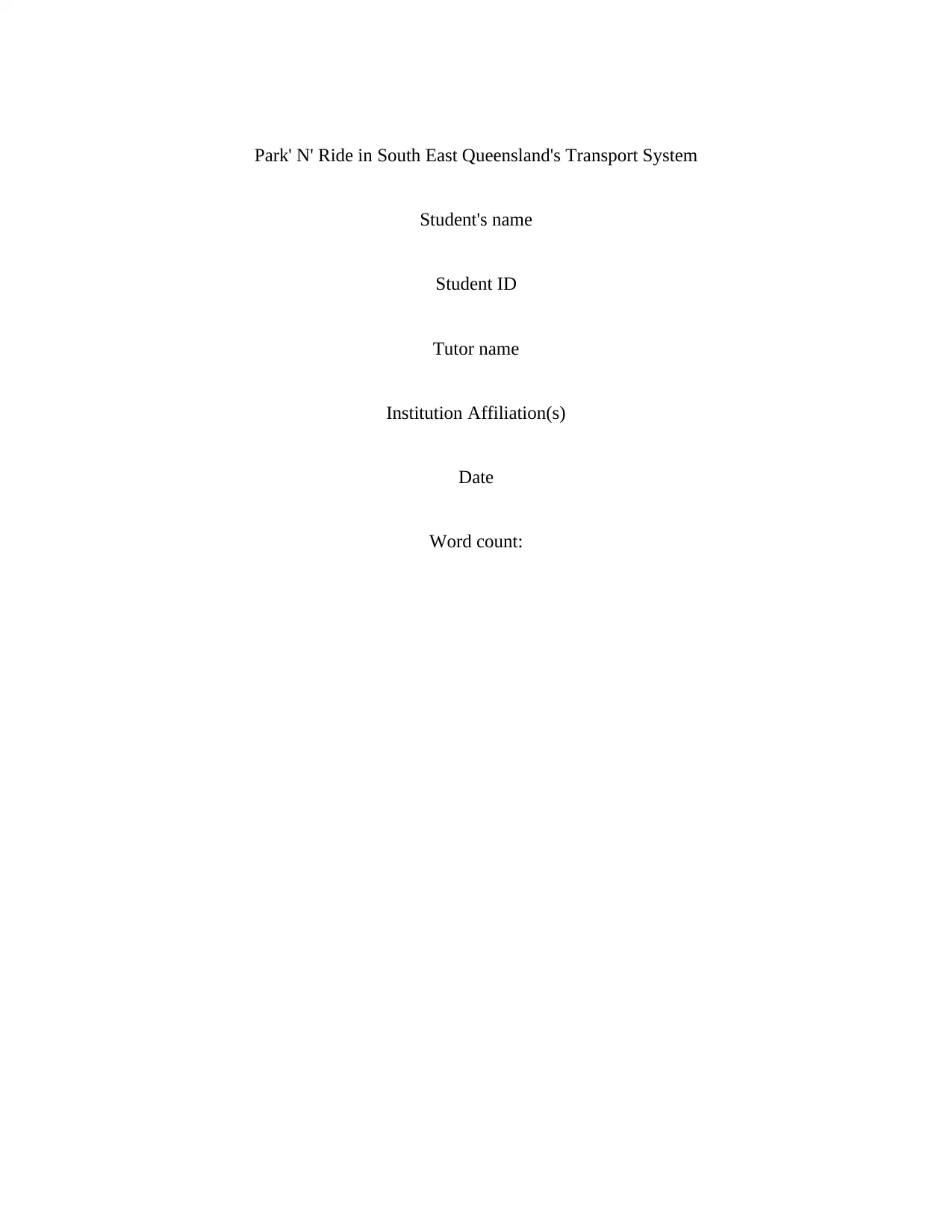
Park' N' Ride in South East Queensland's Transport System
Student's name
Student ID
Tutor name
Institution Affiliation(s)
Date
Word count:
Student's name
Student ID
Tutor name
Institution Affiliation(s)
Date
Word count:
Secure Best Marks with AI Grader
Need help grading? Try our AI Grader for instant feedback on your assignments.
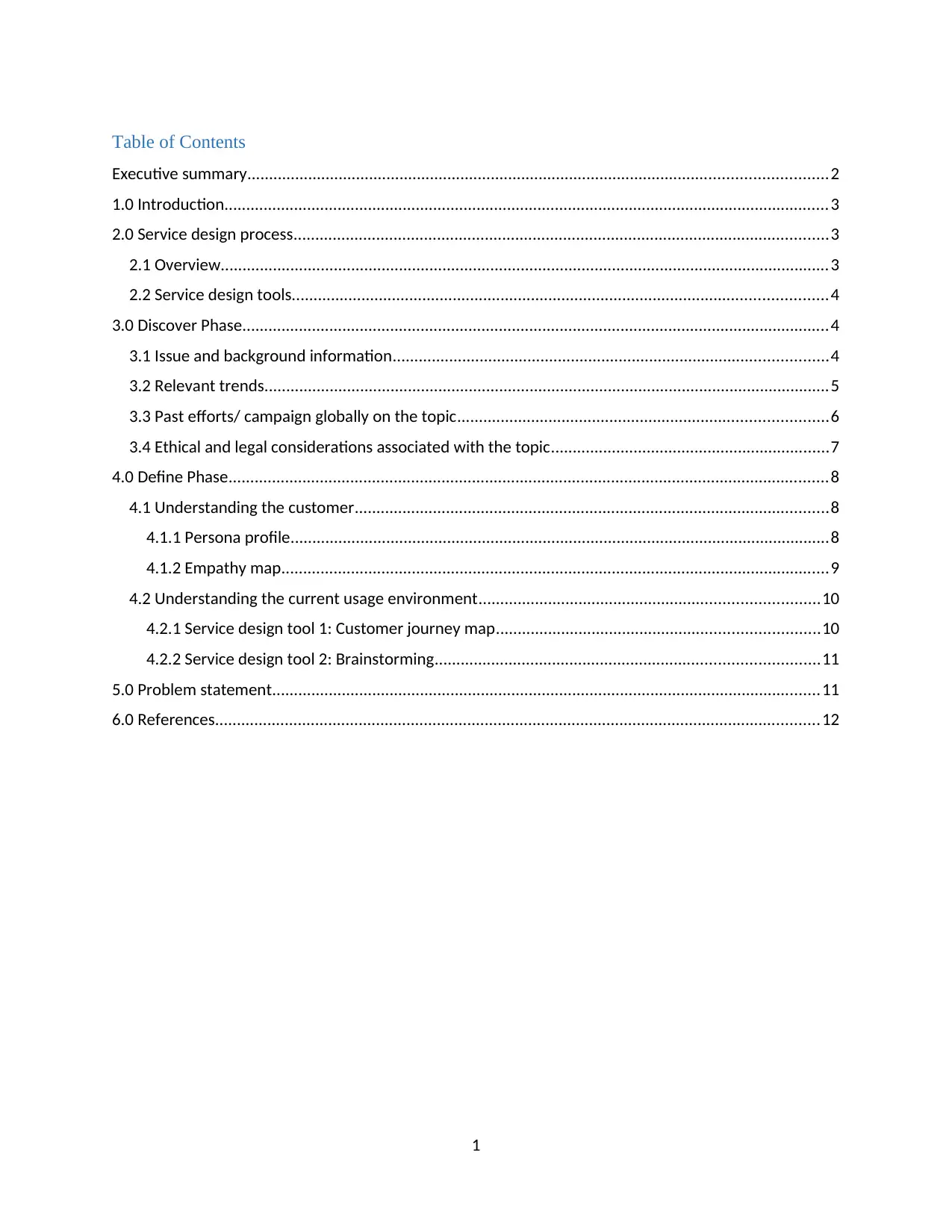
Table of Contents
Executive summary.....................................................................................................................................2
1.0 Introduction...........................................................................................................................................3
2.0 Service design process...........................................................................................................................3
2.1 Overview............................................................................................................................................3
2.2 Service design tools...........................................................................................................................4
3.0 Discover Phase.......................................................................................................................................4
3.1 Issue and background information....................................................................................................4
3.2 Relevant trends..................................................................................................................................5
3.3 Past efforts/ campaign globally on the topic.....................................................................................6
3.4 Ethical and legal considerations associated with the topic................................................................7
4.0 Define Phase..........................................................................................................................................8
4.1 Understanding the customer.............................................................................................................8
4.1.1 Persona profile............................................................................................................................8
4.1.2 Empathy map..............................................................................................................................9
4.2 Understanding the current usage environment..............................................................................10
4.2.1 Service design tool 1: Customer journey map..........................................................................10
4.2.2 Service design tool 2: Brainstorming........................................................................................11
5.0 Problem statement..............................................................................................................................11
6.0 References...........................................................................................................................................12
1
Executive summary.....................................................................................................................................2
1.0 Introduction...........................................................................................................................................3
2.0 Service design process...........................................................................................................................3
2.1 Overview............................................................................................................................................3
2.2 Service design tools...........................................................................................................................4
3.0 Discover Phase.......................................................................................................................................4
3.1 Issue and background information....................................................................................................4
3.2 Relevant trends..................................................................................................................................5
3.3 Past efforts/ campaign globally on the topic.....................................................................................6
3.4 Ethical and legal considerations associated with the topic................................................................7
4.0 Define Phase..........................................................................................................................................8
4.1 Understanding the customer.............................................................................................................8
4.1.1 Persona profile............................................................................................................................8
4.1.2 Empathy map..............................................................................................................................9
4.2 Understanding the current usage environment..............................................................................10
4.2.1 Service design tool 1: Customer journey map..........................................................................10
4.2.2 Service design tool 2: Brainstorming........................................................................................11
5.0 Problem statement..............................................................................................................................11
6.0 References...........................................................................................................................................12
1
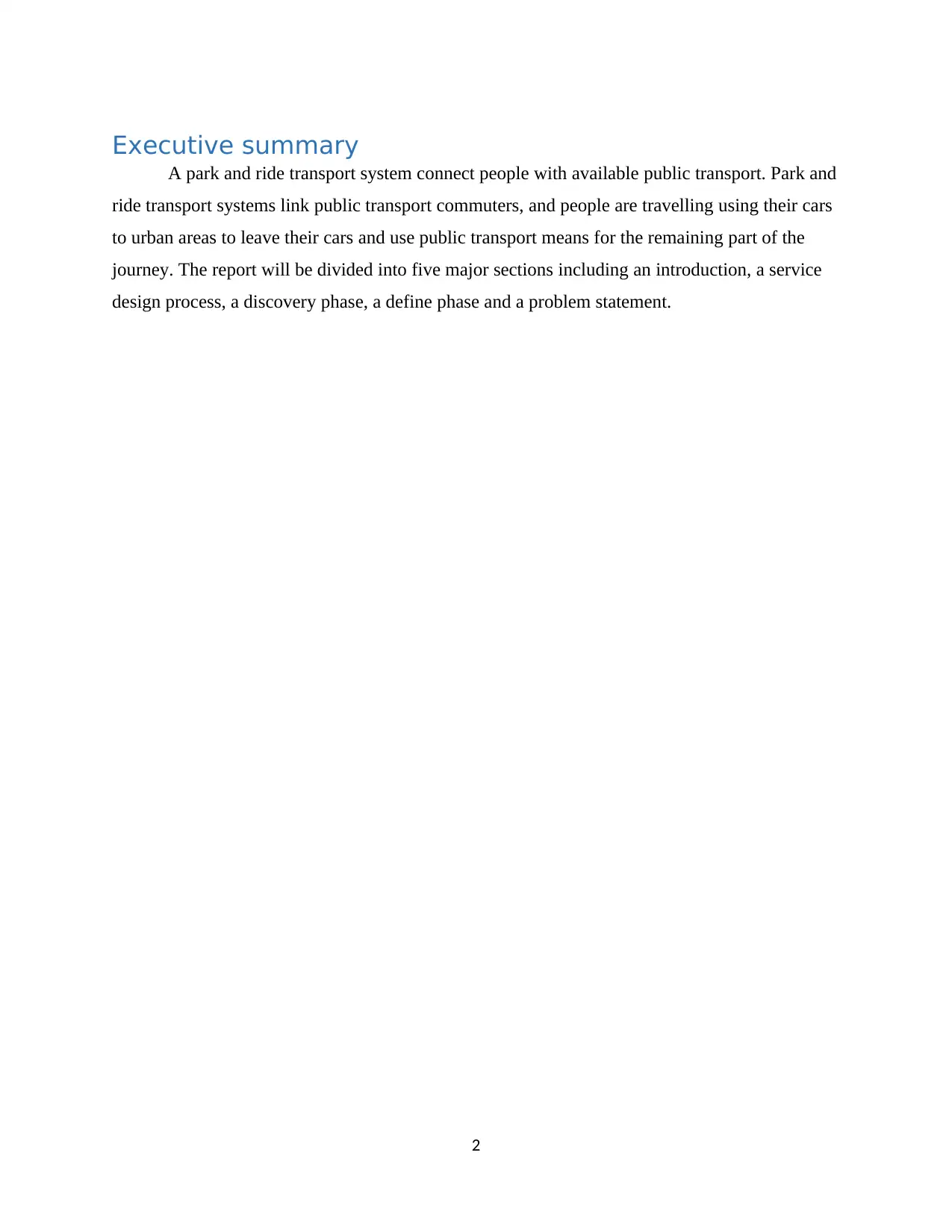
Executive summary
A park and ride transport system connect people with available public transport. Park and
ride transport systems link public transport commuters, and people are travelling using their cars
to urban areas to leave their cars and use public transport means for the remaining part of the
journey. The report will be divided into five major sections including an introduction, a service
design process, a discovery phase, a define phase and a problem statement.
2
A park and ride transport system connect people with available public transport. Park and
ride transport systems link public transport commuters, and people are travelling using their cars
to urban areas to leave their cars and use public transport means for the remaining part of the
journey. The report will be divided into five major sections including an introduction, a service
design process, a discovery phase, a define phase and a problem statement.
2

1.0 Introduction
The Park and Ride system encourage motorists driving into town to park their cars in
secure areas outside the city centre areas then ride on buses and in some cases trams into town.
This is a highly efficient method of reducing traffic congestion in the city. The logic of it is that
one bus with a capacity of fifty passengers can replace 40 or so vehicles that would otherwise be
clogging the road. This system was made more attractive by ensuring that the parking areas are
conveniently close to the Park and Ride buses that would then carry the persons who left their
cars conveniently into the town.
Moreover, a well set up Closed Circuit TV system ensures that all the vehicles are kept
under tight security watch as the owners go about their business. In terms of costs, it is cheaper to
move around in the cars with their low and stable fares. The prospect of driving around in the
London jam with the high costs of vehicle parking in the town plays a great role as a deterrent to
all who wish to hang around town in their cars. And to make the system more efficient, priority
is given to bus transport all around the town to enable the buses to have the right of way in traffic
The efficiency of the Park and Ride system is also further enhanced by the availability of
a large number of staff members to serve clients at all the sites. The staff is available for 24
hours, thus ensuring that adequate service is offered to make it convenient for all potential clients
going for it. This is part of the effort that is made to make the ride an attractive and viable
alternative to motoring. So this method has largely achieved its overall objective of securing a
modal shift towards public transport in order to contain congestion and be environmentally
friendly as well. It has also greatly uplifted public transport and reduced congestion in the city to
a great extent.
2.0 Service design process
2.1 Overview
Service design represents the general outlay of the service provided by various
businesses. Service design actualizes the method and tools used to offer services to customers.
Service design represents the holistic experience of customers who use or desire to borrow the
services of a certain provider (1). The main aim of service design is to ensure that the targeted
market gets the best output and are fully satisfied. The satisfaction of one would simultaneously
incite the satisfaction of another. Service design mechanisms can be incorporated into business
3
The Park and Ride system encourage motorists driving into town to park their cars in
secure areas outside the city centre areas then ride on buses and in some cases trams into town.
This is a highly efficient method of reducing traffic congestion in the city. The logic of it is that
one bus with a capacity of fifty passengers can replace 40 or so vehicles that would otherwise be
clogging the road. This system was made more attractive by ensuring that the parking areas are
conveniently close to the Park and Ride buses that would then carry the persons who left their
cars conveniently into the town.
Moreover, a well set up Closed Circuit TV system ensures that all the vehicles are kept
under tight security watch as the owners go about their business. In terms of costs, it is cheaper to
move around in the cars with their low and stable fares. The prospect of driving around in the
London jam with the high costs of vehicle parking in the town plays a great role as a deterrent to
all who wish to hang around town in their cars. And to make the system more efficient, priority
is given to bus transport all around the town to enable the buses to have the right of way in traffic
The efficiency of the Park and Ride system is also further enhanced by the availability of
a large number of staff members to serve clients at all the sites. The staff is available for 24
hours, thus ensuring that adequate service is offered to make it convenient for all potential clients
going for it. This is part of the effort that is made to make the ride an attractive and viable
alternative to motoring. So this method has largely achieved its overall objective of securing a
modal shift towards public transport in order to contain congestion and be environmentally
friendly as well. It has also greatly uplifted public transport and reduced congestion in the city to
a great extent.
2.0 Service design process
2.1 Overview
Service design represents the general outlay of the service provided by various
businesses. Service design actualizes the method and tools used to offer services to customers.
Service design represents the holistic experience of customers who use or desire to borrow the
services of a certain provider (1). The main aim of service design is to ensure that the targeted
market gets the best output and are fully satisfied. The satisfaction of one would simultaneously
incite the satisfaction of another. Service design mechanisms can be incorporated into business
3
Secure Best Marks with AI Grader
Need help grading? Try our AI Grader for instant feedback on your assignments.
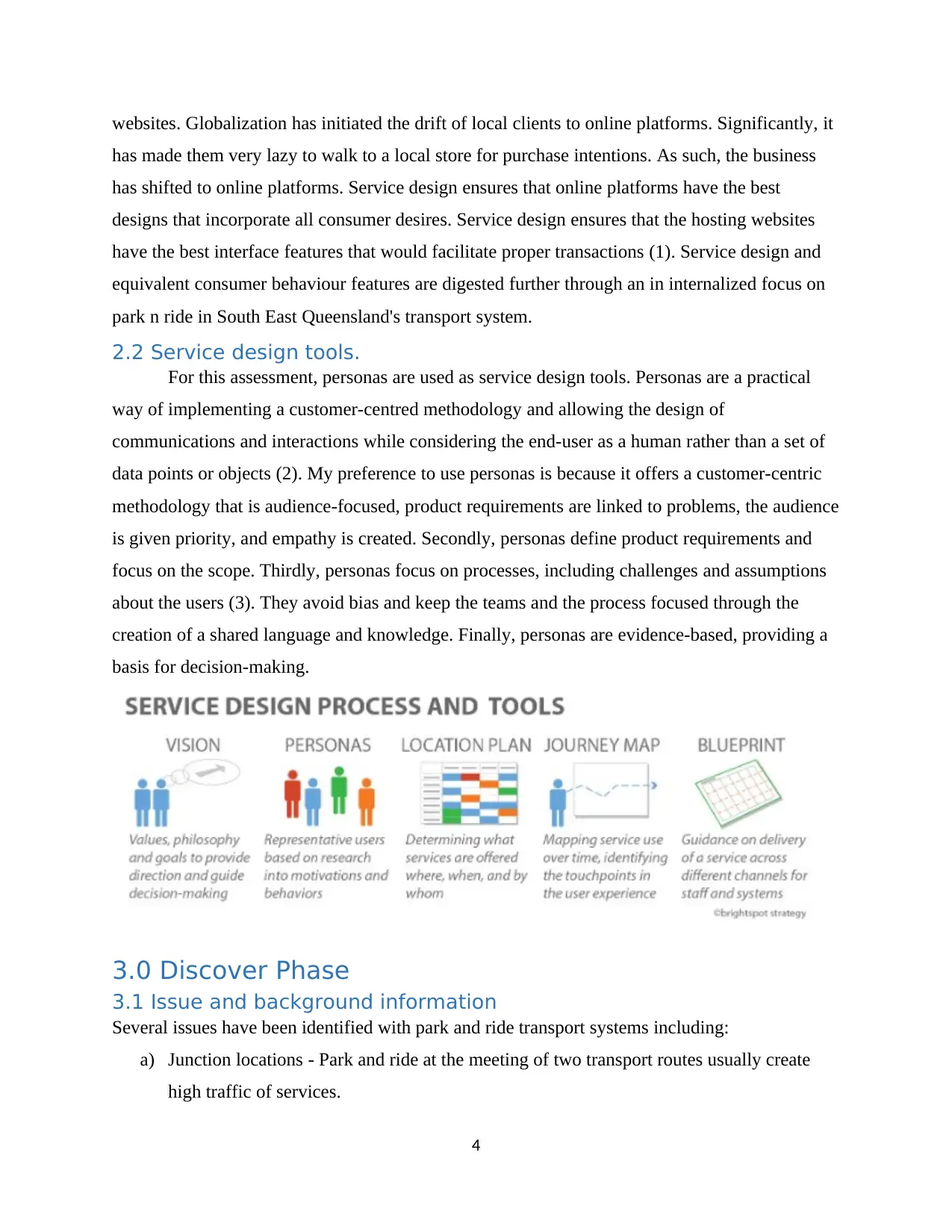
websites. Globalization has initiated the drift of local clients to online platforms. Significantly, it
has made them very lazy to walk to a local store for purchase intentions. As such, the business
has shifted to online platforms. Service design ensures that online platforms have the best
designs that incorporate all consumer desires. Service design ensures that the hosting websites
have the best interface features that would facilitate proper transactions (1). Service design and
equivalent consumer behaviour features are digested further through an in internalized focus on
park n ride in South East Queensland's transport system.
2.2 Service design tools.
For this assessment, personas are used as service design tools. Personas are a practical
way of implementing a customer-centred methodology and allowing the design of
communications and interactions while considering the end-user as a human rather than a set of
data points or objects (2). My preference to use personas is because it offers a customer-centric
methodology that is audience-focused, product requirements are linked to problems, the audience
is given priority, and empathy is created. Secondly, personas define product requirements and
focus on the scope. Thirdly, personas focus on processes, including challenges and assumptions
about the users (3). They avoid bias and keep the teams and the process focused through the
creation of a shared language and knowledge. Finally, personas are evidence-based, providing a
basis for decision-making.
3.0 Discover Phase
3.1 Issue and background information
Several issues have been identified with park and ride transport systems including:
a) Junction locations - Park and ride at the meeting of two transport routes usually create
high traffic of services.
4
has made them very lazy to walk to a local store for purchase intentions. As such, the business
has shifted to online platforms. Service design ensures that online platforms have the best
designs that incorporate all consumer desires. Service design ensures that the hosting websites
have the best interface features that would facilitate proper transactions (1). Service design and
equivalent consumer behaviour features are digested further through an in internalized focus on
park n ride in South East Queensland's transport system.
2.2 Service design tools.
For this assessment, personas are used as service design tools. Personas are a practical
way of implementing a customer-centred methodology and allowing the design of
communications and interactions while considering the end-user as a human rather than a set of
data points or objects (2). My preference to use personas is because it offers a customer-centric
methodology that is audience-focused, product requirements are linked to problems, the audience
is given priority, and empathy is created. Secondly, personas define product requirements and
focus on the scope. Thirdly, personas focus on processes, including challenges and assumptions
about the users (3). They avoid bias and keep the teams and the process focused through the
creation of a shared language and knowledge. Finally, personas are evidence-based, providing a
basis for decision-making.
3.0 Discover Phase
3.1 Issue and background information
Several issues have been identified with park and ride transport systems including:
a) Junction locations - Park and ride at the meeting of two transport routes usually create
high traffic of services.
4
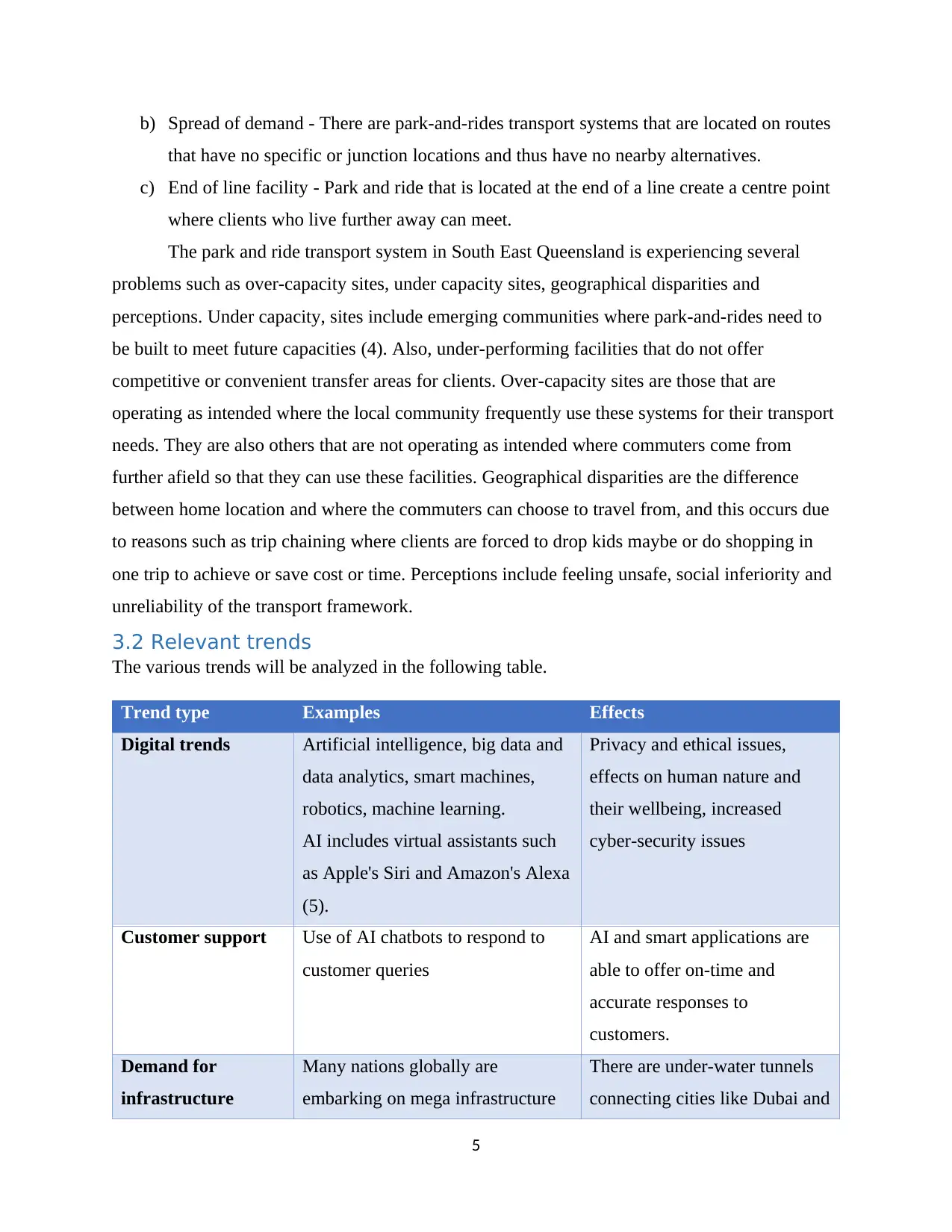
b) Spread of demand - There are park-and-rides transport systems that are located on routes
that have no specific or junction locations and thus have no nearby alternatives.
c) End of line facility - Park and ride that is located at the end of a line create a centre point
where clients who live further away can meet.
The park and ride transport system in South East Queensland is experiencing several
problems such as over-capacity sites, under capacity sites, geographical disparities and
perceptions. Under capacity, sites include emerging communities where park-and-rides need to
be built to meet future capacities (4). Also, under-performing facilities that do not offer
competitive or convenient transfer areas for clients. Over-capacity sites are those that are
operating as intended where the local community frequently use these systems for their transport
needs. They are also others that are not operating as intended where commuters come from
further afield so that they can use these facilities. Geographical disparities are the difference
between home location and where the commuters can choose to travel from, and this occurs due
to reasons such as trip chaining where clients are forced to drop kids maybe or do shopping in
one trip to achieve or save cost or time. Perceptions include feeling unsafe, social inferiority and
unreliability of the transport framework.
3.2 Relevant trends
The various trends will be analyzed in the following table.
Trend type Examples Effects
Digital trends Artificial intelligence, big data and
data analytics, smart machines,
robotics, machine learning.
AI includes virtual assistants such
as Apple's Siri and Amazon's Alexa
(5).
Privacy and ethical issues,
effects on human nature and
their wellbeing, increased
cyber-security issues
Customer support Use of AI chatbots to respond to
customer queries
AI and smart applications are
able to offer on-time and
accurate responses to
customers.
Demand for
infrastructure
Many nations globally are
embarking on mega infrastructure
There are under-water tunnels
connecting cities like Dubai and
5
that have no specific or junction locations and thus have no nearby alternatives.
c) End of line facility - Park and ride that is located at the end of a line create a centre point
where clients who live further away can meet.
The park and ride transport system in South East Queensland is experiencing several
problems such as over-capacity sites, under capacity sites, geographical disparities and
perceptions. Under capacity, sites include emerging communities where park-and-rides need to
be built to meet future capacities (4). Also, under-performing facilities that do not offer
competitive or convenient transfer areas for clients. Over-capacity sites are those that are
operating as intended where the local community frequently use these systems for their transport
needs. They are also others that are not operating as intended where commuters come from
further afield so that they can use these facilities. Geographical disparities are the difference
between home location and where the commuters can choose to travel from, and this occurs due
to reasons such as trip chaining where clients are forced to drop kids maybe or do shopping in
one trip to achieve or save cost or time. Perceptions include feeling unsafe, social inferiority and
unreliability of the transport framework.
3.2 Relevant trends
The various trends will be analyzed in the following table.
Trend type Examples Effects
Digital trends Artificial intelligence, big data and
data analytics, smart machines,
robotics, machine learning.
AI includes virtual assistants such
as Apple's Siri and Amazon's Alexa
(5).
Privacy and ethical issues,
effects on human nature and
their wellbeing, increased
cyber-security issues
Customer support Use of AI chatbots to respond to
customer queries
AI and smart applications are
able to offer on-time and
accurate responses to
customers.
Demand for
infrastructure
Many nations globally are
embarking on mega infrastructure
There are under-water tunnels
connecting cities like Dubai and
5
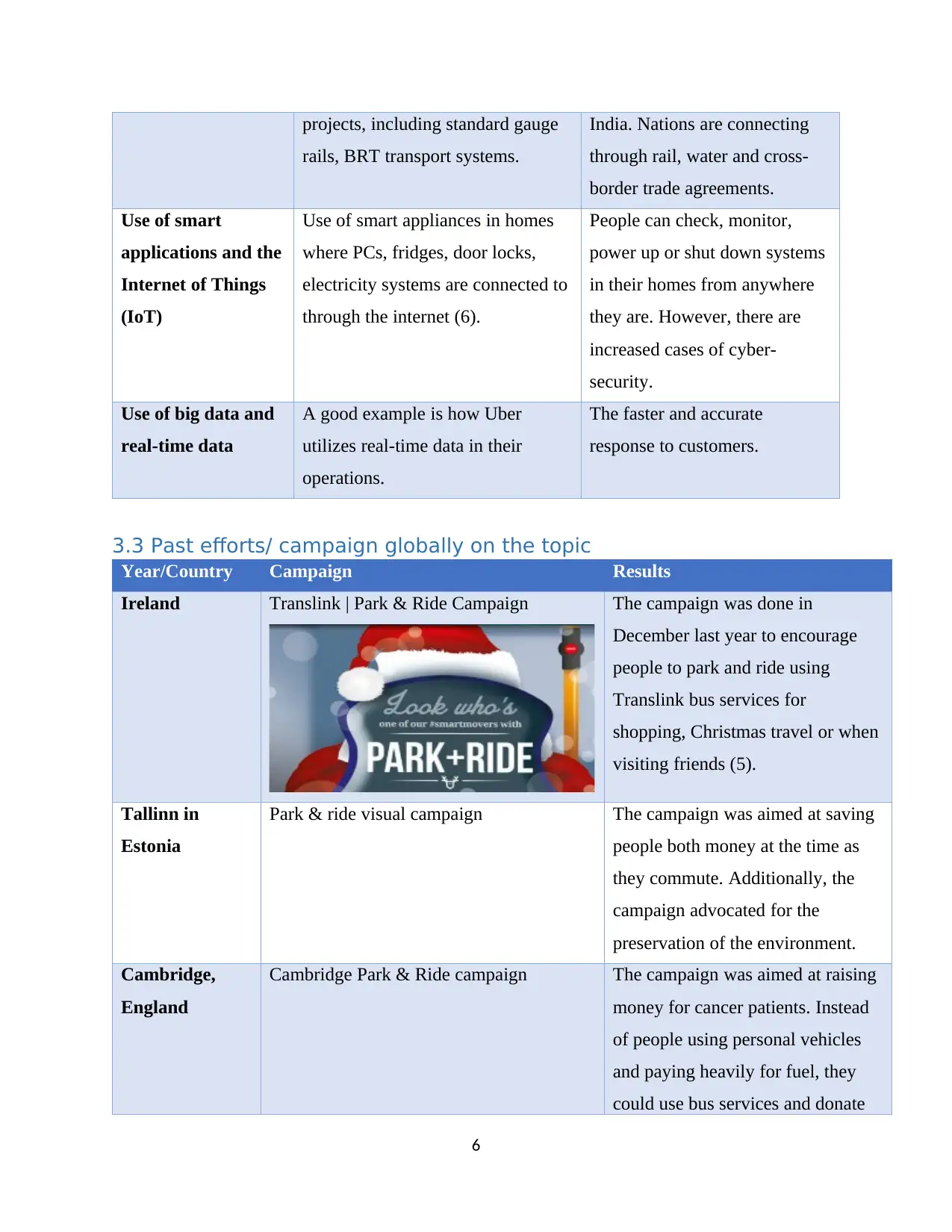
projects, including standard gauge
rails, BRT transport systems.
India. Nations are connecting
through rail, water and cross-
border trade agreements.
Use of smart
applications and the
Internet of Things
(IoT)
Use of smart appliances in homes
where PCs, fridges, door locks,
electricity systems are connected to
through the internet (6).
People can check, monitor,
power up or shut down systems
in their homes from anywhere
they are. However, there are
increased cases of cyber-
security.
Use of big data and
real-time data
A good example is how Uber
utilizes real-time data in their
operations.
The faster and accurate
response to customers.
3.3 Past efforts/ campaign globally on the topic
Year/Country Campaign Results
Ireland Translink | Park & Ride Campaign The campaign was done in
December last year to encourage
people to park and ride using
Translink bus services for
shopping, Christmas travel or when
visiting friends (5).
Tallinn in
Estonia
Park & ride visual campaign The campaign was aimed at saving
people both money at the time as
they commute. Additionally, the
campaign advocated for the
preservation of the environment.
Cambridge,
England
Cambridge Park & Ride campaign The campaign was aimed at raising
money for cancer patients. Instead
of people using personal vehicles
and paying heavily for fuel, they
could use bus services and donate
6
rails, BRT transport systems.
India. Nations are connecting
through rail, water and cross-
border trade agreements.
Use of smart
applications and the
Internet of Things
(IoT)
Use of smart appliances in homes
where PCs, fridges, door locks,
electricity systems are connected to
through the internet (6).
People can check, monitor,
power up or shut down systems
in their homes from anywhere
they are. However, there are
increased cases of cyber-
security.
Use of big data and
real-time data
A good example is how Uber
utilizes real-time data in their
operations.
The faster and accurate
response to customers.
3.3 Past efforts/ campaign globally on the topic
Year/Country Campaign Results
Ireland Translink | Park & Ride Campaign The campaign was done in
December last year to encourage
people to park and ride using
Translink bus services for
shopping, Christmas travel or when
visiting friends (5).
Tallinn in
Estonia
Park & ride visual campaign The campaign was aimed at saving
people both money at the time as
they commute. Additionally, the
campaign advocated for the
preservation of the environment.
Cambridge,
England
Cambridge Park & Ride campaign The campaign was aimed at raising
money for cancer patients. Instead
of people using personal vehicles
and paying heavily for fuel, they
could use bus services and donate
6
Paraphrase This Document
Need a fresh take? Get an instant paraphrase of this document with our AI Paraphraser
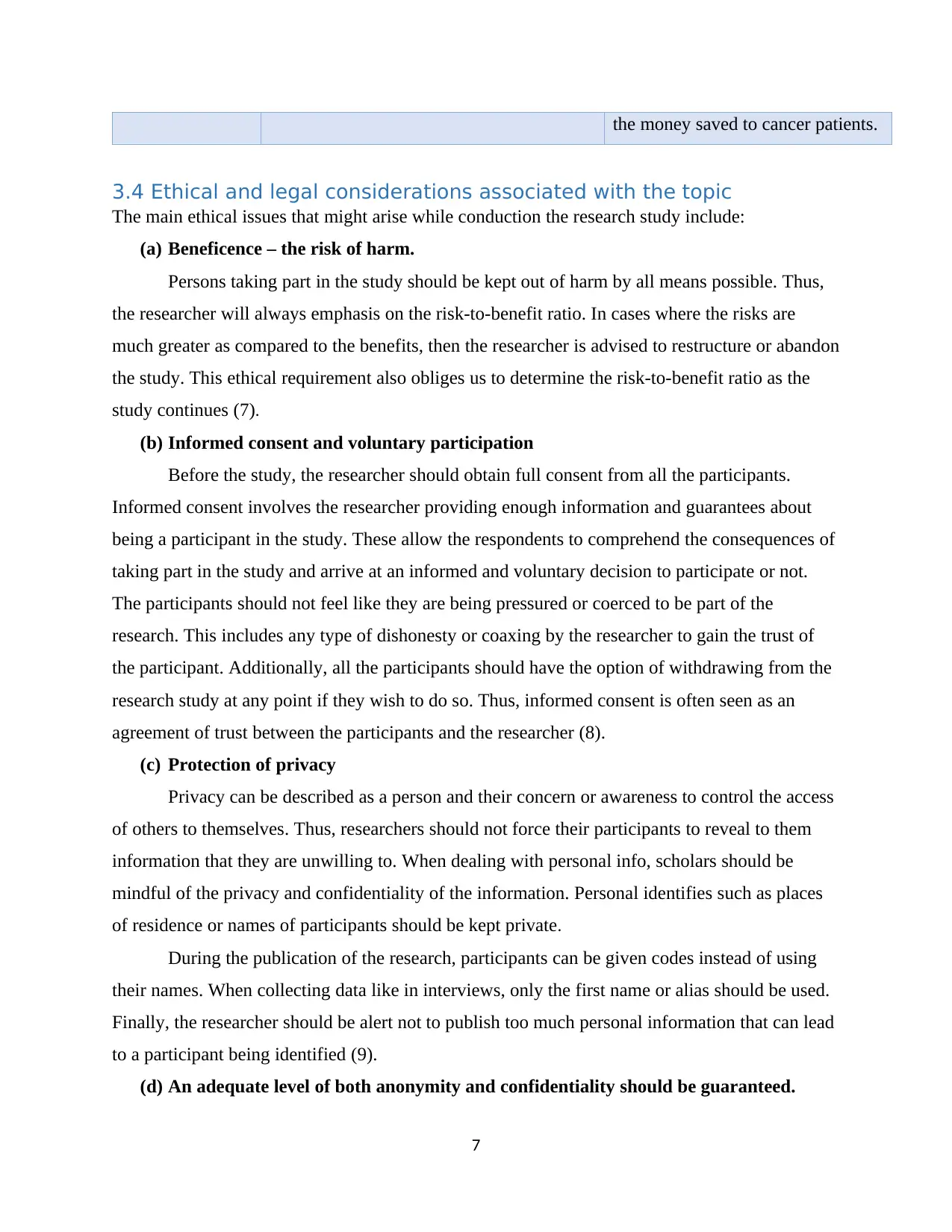
the money saved to cancer patients.
3.4 Ethical and legal considerations associated with the topic
The main ethical issues that might arise while conduction the research study include:
(a) Beneficence – the risk of harm.
Persons taking part in the study should be kept out of harm by all means possible. Thus,
the researcher will always emphasis on the risk-to-benefit ratio. In cases where the risks are
much greater as compared to the benefits, then the researcher is advised to restructure or abandon
the study. This ethical requirement also obliges us to determine the risk-to-benefit ratio as the
study continues (7).
(b) Informed consent and voluntary participation
Before the study, the researcher should obtain full consent from all the participants.
Informed consent involves the researcher providing enough information and guarantees about
being a participant in the study. These allow the respondents to comprehend the consequences of
taking part in the study and arrive at an informed and voluntary decision to participate or not.
The participants should not feel like they are being pressured or coerced to be part of the
research. This includes any type of dishonesty or coaxing by the researcher to gain the trust of
the participant. Additionally, all the participants should have the option of withdrawing from the
research study at any point if they wish to do so. Thus, informed consent is often seen as an
agreement of trust between the participants and the researcher (8).
(c) Protection of privacy
Privacy can be described as a person and their concern or awareness to control the access
of others to themselves. Thus, researchers should not force their participants to reveal to them
information that they are unwilling to. When dealing with personal info, scholars should be
mindful of the privacy and confidentiality of the information. Personal identifies such as places
of residence or names of participants should be kept private.
During the publication of the research, participants can be given codes instead of using
their names. When collecting data like in interviews, only the first name or alias should be used.
Finally, the researcher should be alert not to publish too much personal information that can lead
to a participant being identified (9).
(d) An adequate level of both anonymity and confidentiality should be guaranteed.
7
3.4 Ethical and legal considerations associated with the topic
The main ethical issues that might arise while conduction the research study include:
(a) Beneficence – the risk of harm.
Persons taking part in the study should be kept out of harm by all means possible. Thus,
the researcher will always emphasis on the risk-to-benefit ratio. In cases where the risks are
much greater as compared to the benefits, then the researcher is advised to restructure or abandon
the study. This ethical requirement also obliges us to determine the risk-to-benefit ratio as the
study continues (7).
(b) Informed consent and voluntary participation
Before the study, the researcher should obtain full consent from all the participants.
Informed consent involves the researcher providing enough information and guarantees about
being a participant in the study. These allow the respondents to comprehend the consequences of
taking part in the study and arrive at an informed and voluntary decision to participate or not.
The participants should not feel like they are being pressured or coerced to be part of the
research. This includes any type of dishonesty or coaxing by the researcher to gain the trust of
the participant. Additionally, all the participants should have the option of withdrawing from the
research study at any point if they wish to do so. Thus, informed consent is often seen as an
agreement of trust between the participants and the researcher (8).
(c) Protection of privacy
Privacy can be described as a person and their concern or awareness to control the access
of others to themselves. Thus, researchers should not force their participants to reveal to them
information that they are unwilling to. When dealing with personal info, scholars should be
mindful of the privacy and confidentiality of the information. Personal identifies such as places
of residence or names of participants should be kept private.
During the publication of the research, participants can be given codes instead of using
their names. When collecting data like in interviews, only the first name or alias should be used.
Finally, the researcher should be alert not to publish too much personal information that can lead
to a participant being identified (9).
(d) An adequate level of both anonymity and confidentiality should be guaranteed.
7
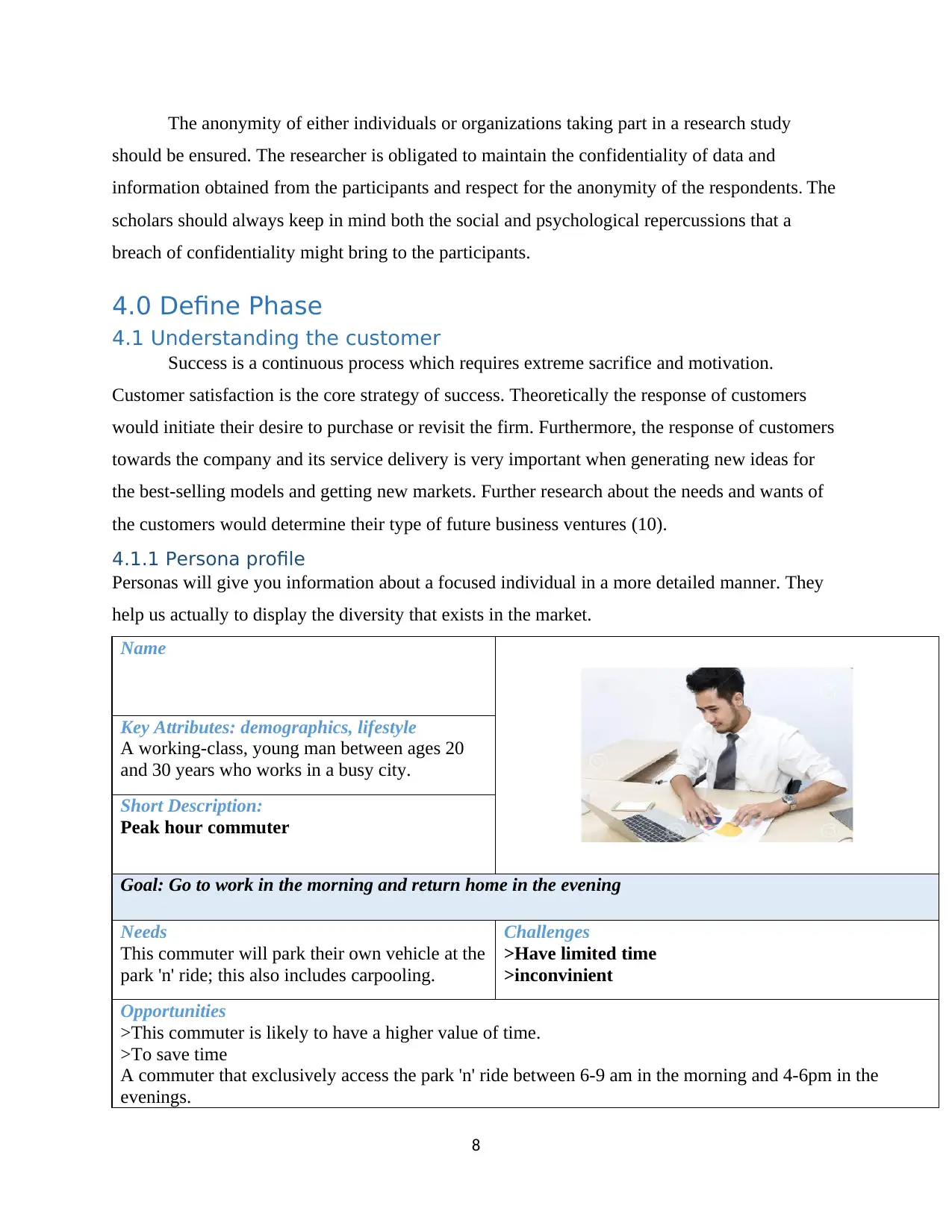
The anonymity of either individuals or organizations taking part in a research study
should be ensured. The researcher is obligated to maintain the confidentiality of data and
information obtained from the participants and respect for the anonymity of the respondents. The
scholars should always keep in mind both the social and psychological repercussions that a
breach of confidentiality might bring to the participants.
4.0 Define Phase
4.1 Understanding the customer
Success is a continuous process which requires extreme sacrifice and motivation.
Customer satisfaction is the core strategy of success. Theoretically the response of customers
would initiate their desire to purchase or revisit the firm. Furthermore, the response of customers
towards the company and its service delivery is very important when generating new ideas for
the best-selling models and getting new markets. Further research about the needs and wants of
the customers would determine their type of future business ventures (10).
4.1.1 Persona profile
Personas will give you information about a focused individual in a more detailed manner. They
help us actually to display the diversity that exists in the market.
Name
Key Attributes: demographics, lifestyle
A working-class, young man between ages 20
and 30 years who works in a busy city.
Short Description:
Peak hour commuter
Goal: Go to work in the morning and return home in the evening
Needs
This commuter will park their own vehicle at the
park 'n' ride; this also includes carpooling.
Challenges
>Have limited time
>inconvinient
Opportunities
>This commuter is likely to have a higher value of time.
>To save time
A commuter that exclusively access the park 'n' ride between 6-9 am in the morning and 4-6pm in the
evenings.
8
should be ensured. The researcher is obligated to maintain the confidentiality of data and
information obtained from the participants and respect for the anonymity of the respondents. The
scholars should always keep in mind both the social and psychological repercussions that a
breach of confidentiality might bring to the participants.
4.0 Define Phase
4.1 Understanding the customer
Success is a continuous process which requires extreme sacrifice and motivation.
Customer satisfaction is the core strategy of success. Theoretically the response of customers
would initiate their desire to purchase or revisit the firm. Furthermore, the response of customers
towards the company and its service delivery is very important when generating new ideas for
the best-selling models and getting new markets. Further research about the needs and wants of
the customers would determine their type of future business ventures (10).
4.1.1 Persona profile
Personas will give you information about a focused individual in a more detailed manner. They
help us actually to display the diversity that exists in the market.
Name
Key Attributes: demographics, lifestyle
A working-class, young man between ages 20
and 30 years who works in a busy city.
Short Description:
Peak hour commuter
Goal: Go to work in the morning and return home in the evening
Needs
This commuter will park their own vehicle at the
park 'n' ride; this also includes carpooling.
Challenges
>Have limited time
>inconvinient
Opportunities
>This commuter is likely to have a higher value of time.
>To save time
A commuter that exclusively access the park 'n' ride between 6-9 am in the morning and 4-6pm in the
evenings.
8
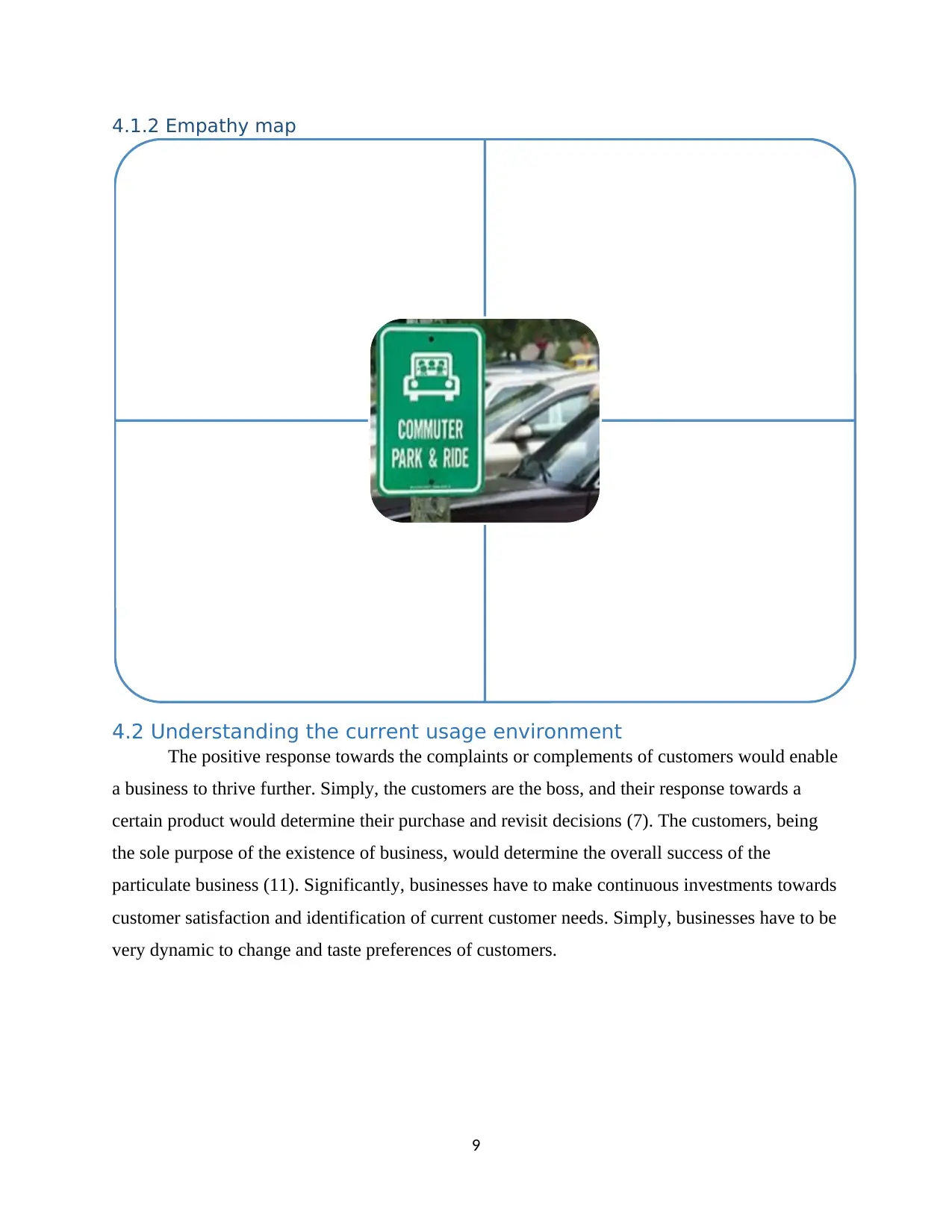
4.1.2 Empathy map
4.2 Understanding the current usage environment
The positive response towards the complaints or complements of customers would enable
a business to thrive further. Simply, the customers are the boss, and their response towards a
certain product would determine their purchase and revisit decisions (7). The customers, being
the sole purpose of the existence of business, would determine the overall success of the
particulate business (11). Significantly, businesses have to make continuous investments towards
customer satisfaction and identification of current customer needs. Simply, businesses have to be
very dynamic to change and taste preferences of customers.
9
>"Gated community allows only residents to
park in that area, even on the streets"
>Prefer to have control of parking around my
property - not a homeowner's association"
'Different zones in the heart of the city make it
difficult to know the rules of parking
restrictions" -Lots fill up quickly so it would
be nice to know if there is street parking
available around that area"
>Parking instructions are very vague on the
signs >Would like to help people find
parking near their area
>Wish they knew about construction work
happening in their area
>Wants to find more guest parking spots
around the neighbourhood
>Search Google- for parking lots around
them
>Lives close to public transport to avoid
driving too much
>Organizes guest parking spots by browsing
the area personally
>Safe when they know who is parking next to
them.
>Confused by parking signs
>Nervous when parking ery far from
workplace
>Angry if fined for wrong parking
4.2 Understanding the current usage environment
The positive response towards the complaints or complements of customers would enable
a business to thrive further. Simply, the customers are the boss, and their response towards a
certain product would determine their purchase and revisit decisions (7). The customers, being
the sole purpose of the existence of business, would determine the overall success of the
particulate business (11). Significantly, businesses have to make continuous investments towards
customer satisfaction and identification of current customer needs. Simply, businesses have to be
very dynamic to change and taste preferences of customers.
9
>"Gated community allows only residents to
park in that area, even on the streets"
>Prefer to have control of parking around my
property - not a homeowner's association"
'Different zones in the heart of the city make it
difficult to know the rules of parking
restrictions" -Lots fill up quickly so it would
be nice to know if there is street parking
available around that area"
>Parking instructions are very vague on the
signs >Would like to help people find
parking near their area
>Wish they knew about construction work
happening in their area
>Wants to find more guest parking spots
around the neighbourhood
>Search Google- for parking lots around
them
>Lives close to public transport to avoid
driving too much
>Organizes guest parking spots by browsing
the area personally
>Safe when they know who is parking next to
them.
>Confused by parking signs
>Nervous when parking ery far from
workplace
>Angry if fined for wrong parking
Secure Best Marks with AI Grader
Need help grading? Try our AI Grader for instant feedback on your assignments.
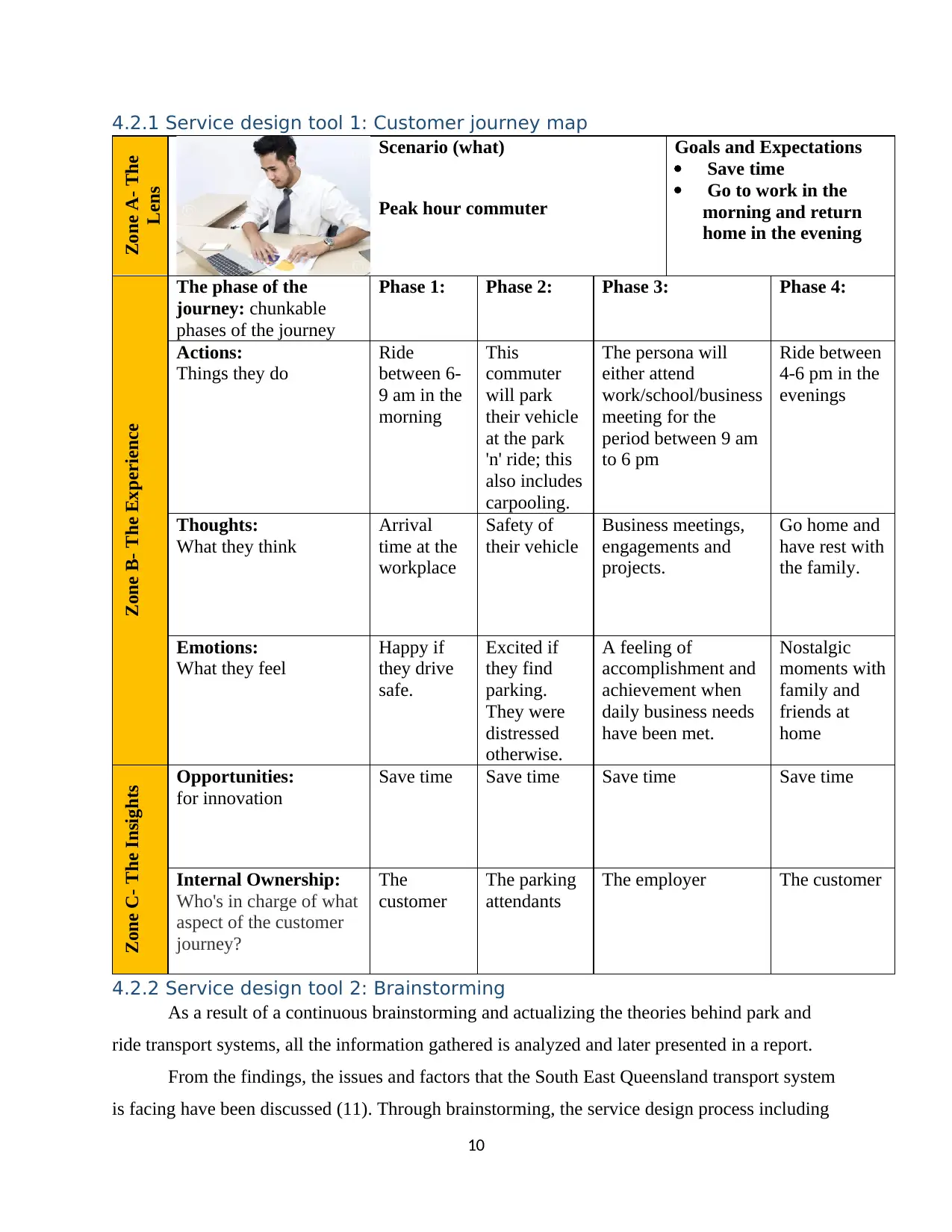
4.2.1 Service design tool 1: Customer journey map
Zone A- The
Lens
Scenario (what)
Peak hour commuter
Goals and Expectations
Save time
Go to work in the
morning and return
home in the evening
Zone B- The Experience
The phase of the
journey: chunkable
phases of the journey
Phase 1: Phase 2: Phase 3: Phase 4:
Actions:
Things they do
Ride
between 6-
9 am in the
morning
This
commuter
will park
their vehicle
at the park
'n' ride; this
also includes
carpooling.
The persona will
either attend
work/school/business
meeting for the
period between 9 am
to 6 pm
Ride between
4-6 pm in the
evenings
Thoughts:
What they think
Arrival
time at the
workplace
Safety of
their vehicle
Business meetings,
engagements and
projects.
Go home and
have rest with
the family.
Emotions:
What they feel
Happy if
they drive
safe.
Excited if
they find
parking.
They were
distressed
otherwise.
A feeling of
accomplishment and
achievement when
daily business needs
have been met.
Nostalgic
moments with
family and
friends at
home
Zone C- The Insights Opportunities:
for innovation
Save time Save time Save time Save time
Internal Ownership:
Who's in charge of what
aspect of the customer
journey?
The
customer
The parking
attendants
The employer The customer
4.2.2 Service design tool 2: Brainstorming
As a result of a continuous brainstorming and actualizing the theories behind park and
ride transport systems, all the information gathered is analyzed and later presented in a report.
From the findings, the issues and factors that the South East Queensland transport system
is facing have been discussed (11). Through brainstorming, the service design process including
10
Zone A- The
Lens
Scenario (what)
Peak hour commuter
Goals and Expectations
Save time
Go to work in the
morning and return
home in the evening
Zone B- The Experience
The phase of the
journey: chunkable
phases of the journey
Phase 1: Phase 2: Phase 3: Phase 4:
Actions:
Things they do
Ride
between 6-
9 am in the
morning
This
commuter
will park
their vehicle
at the park
'n' ride; this
also includes
carpooling.
The persona will
either attend
work/school/business
meeting for the
period between 9 am
to 6 pm
Ride between
4-6 pm in the
evenings
Thoughts:
What they think
Arrival
time at the
workplace
Safety of
their vehicle
Business meetings,
engagements and
projects.
Go home and
have rest with
the family.
Emotions:
What they feel
Happy if
they drive
safe.
Excited if
they find
parking.
They were
distressed
otherwise.
A feeling of
accomplishment and
achievement when
daily business needs
have been met.
Nostalgic
moments with
family and
friends at
home
Zone C- The Insights Opportunities:
for innovation
Save time Save time Save time Save time
Internal Ownership:
Who's in charge of what
aspect of the customer
journey?
The
customer
The parking
attendants
The employer The customer
4.2.2 Service design tool 2: Brainstorming
As a result of a continuous brainstorming and actualizing the theories behind park and
ride transport systems, all the information gathered is analyzed and later presented in a report.
From the findings, the issues and factors that the South East Queensland transport system
is facing have been discussed (11). Through brainstorming, the service design process including
10
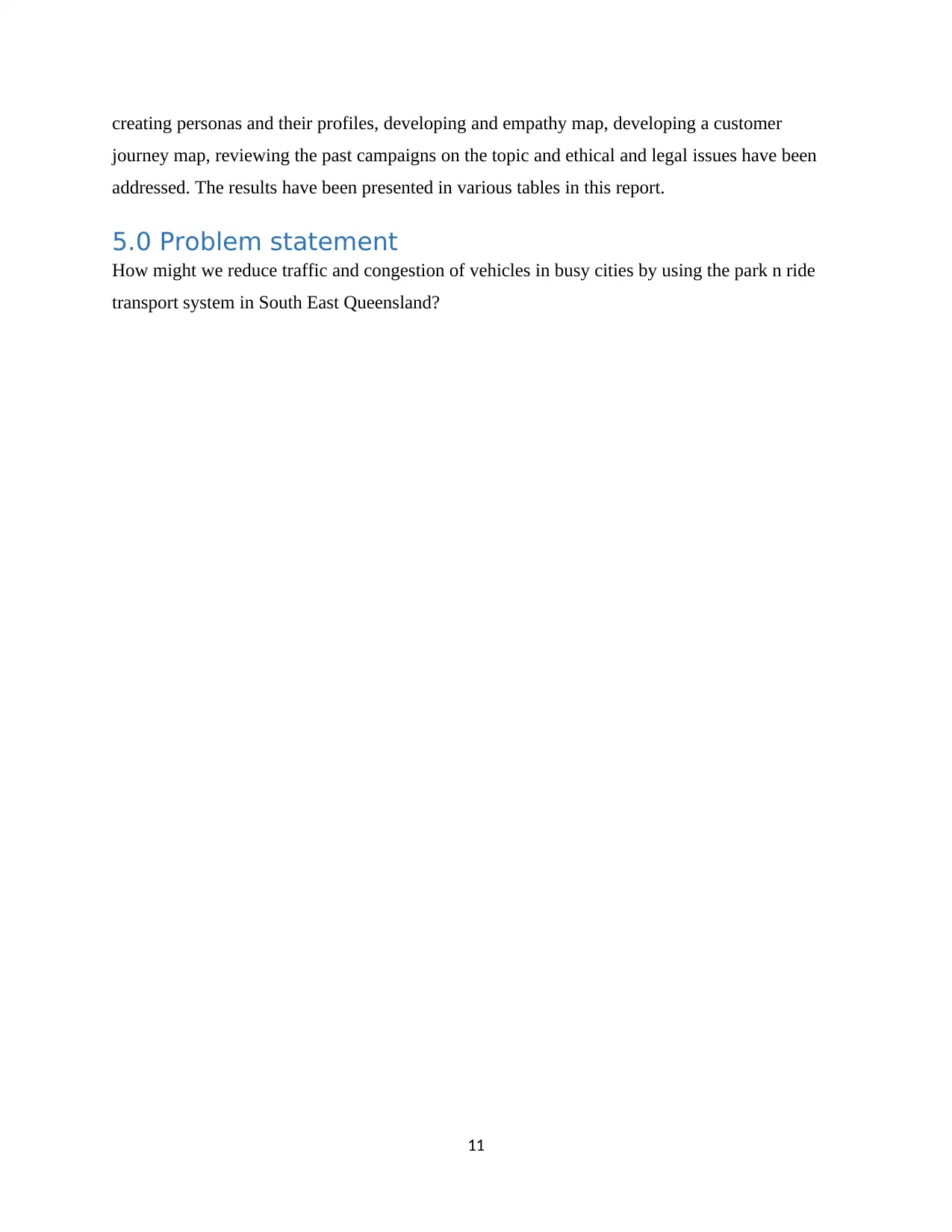
creating personas and their profiles, developing and empathy map, developing a customer
journey map, reviewing the past campaigns on the topic and ethical and legal issues have been
addressed. The results have been presented in various tables in this report.
5.0 Problem statement
How might we reduce traffic and congestion of vehicles in busy cities by using the park n ride
transport system in South East Queensland?
11
journey map, reviewing the past campaigns on the topic and ethical and legal issues have been
addressed. The results have been presented in various tables in this report.
5.0 Problem statement
How might we reduce traffic and congestion of vehicles in busy cities by using the park n ride
transport system in South East Queensland?
11
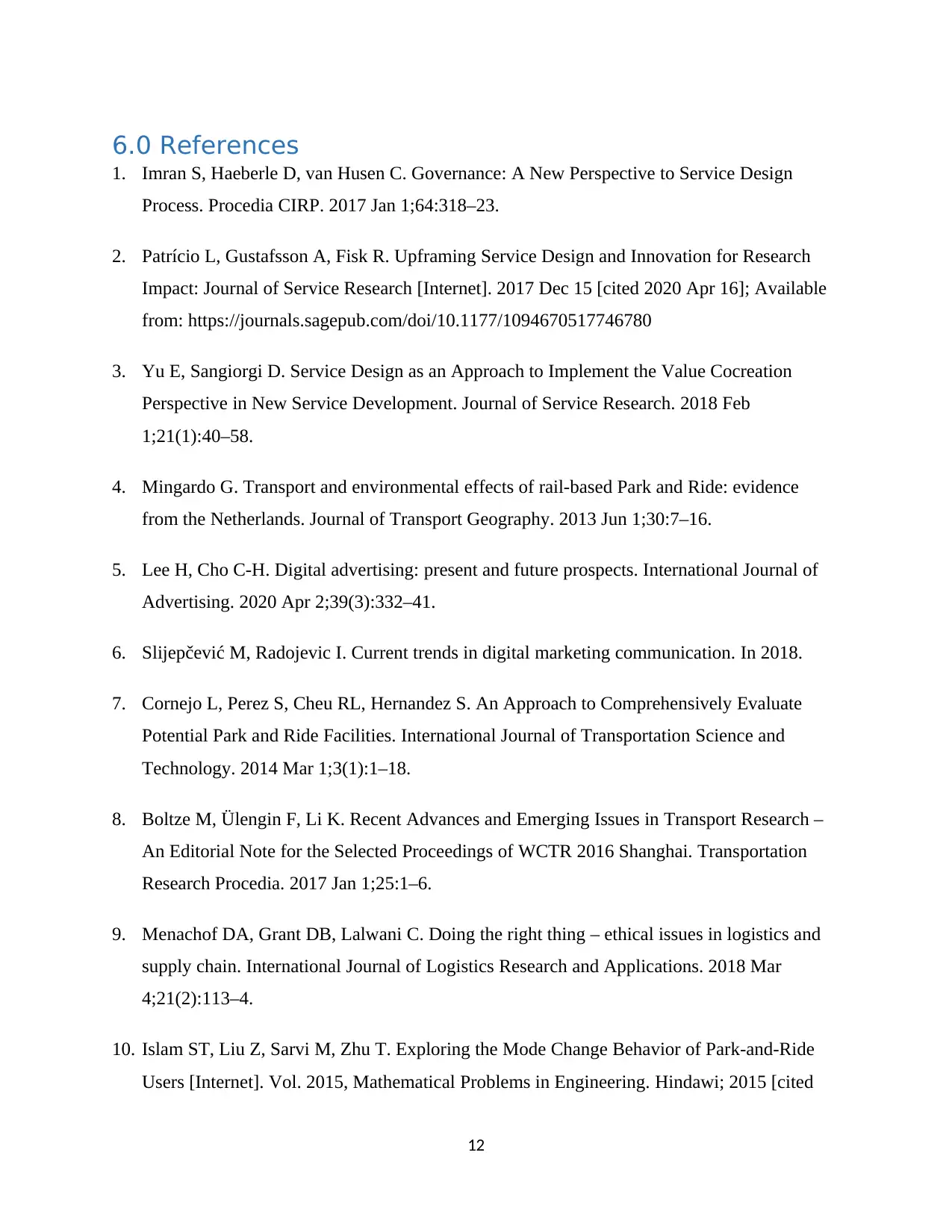
6.0 References
1. Imran S, Haeberle D, van Husen C. Governance: A New Perspective to Service Design
Process. Procedia CIRP. 2017 Jan 1;64:318–23.
2. Patrício L, Gustafsson A, Fisk R. Upframing Service Design and Innovation for Research
Impact: Journal of Service Research [Internet]. 2017 Dec 15 [cited 2020 Apr 16]; Available
from: https://journals.sagepub.com/doi/10.1177/1094670517746780
3. Yu E, Sangiorgi D. Service Design as an Approach to Implement the Value Cocreation
Perspective in New Service Development. Journal of Service Research. 2018 Feb
1;21(1):40–58.
4. Mingardo G. Transport and environmental effects of rail-based Park and Ride: evidence
from the Netherlands. Journal of Transport Geography. 2013 Jun 1;30:7–16.
5. Lee H, Cho C-H. Digital advertising: present and future prospects. International Journal of
Advertising. 2020 Apr 2;39(3):332–41.
6. Slijepčević M, Radojevic I. Current trends in digital marketing communication. In 2018.
7. Cornejo L, Perez S, Cheu RL, Hernandez S. An Approach to Comprehensively Evaluate
Potential Park and Ride Facilities. International Journal of Transportation Science and
Technology. 2014 Mar 1;3(1):1–18.
8. Boltze M, Ülengin F, Li K. Recent Advances and Emerging Issues in Transport Research –
An Editorial Note for the Selected Proceedings of WCTR 2016 Shanghai. Transportation
Research Procedia. 2017 Jan 1;25:1–6.
9. Menachof DA, Grant DB, Lalwani C. Doing the right thing – ethical issues in logistics and
supply chain. International Journal of Logistics Research and Applications. 2018 Mar
4;21(2):113–4.
10. Islam ST, Liu Z, Sarvi M, Zhu T. Exploring the Mode Change Behavior of Park-and-Ride
Users [Internet]. Vol. 2015, Mathematical Problems in Engineering. Hindawi; 2015 [cited
12
1. Imran S, Haeberle D, van Husen C. Governance: A New Perspective to Service Design
Process. Procedia CIRP. 2017 Jan 1;64:318–23.
2. Patrício L, Gustafsson A, Fisk R. Upframing Service Design and Innovation for Research
Impact: Journal of Service Research [Internet]. 2017 Dec 15 [cited 2020 Apr 16]; Available
from: https://journals.sagepub.com/doi/10.1177/1094670517746780
3. Yu E, Sangiorgi D. Service Design as an Approach to Implement the Value Cocreation
Perspective in New Service Development. Journal of Service Research. 2018 Feb
1;21(1):40–58.
4. Mingardo G. Transport and environmental effects of rail-based Park and Ride: evidence
from the Netherlands. Journal of Transport Geography. 2013 Jun 1;30:7–16.
5. Lee H, Cho C-H. Digital advertising: present and future prospects. International Journal of
Advertising. 2020 Apr 2;39(3):332–41.
6. Slijepčević M, Radojevic I. Current trends in digital marketing communication. In 2018.
7. Cornejo L, Perez S, Cheu RL, Hernandez S. An Approach to Comprehensively Evaluate
Potential Park and Ride Facilities. International Journal of Transportation Science and
Technology. 2014 Mar 1;3(1):1–18.
8. Boltze M, Ülengin F, Li K. Recent Advances and Emerging Issues in Transport Research –
An Editorial Note for the Selected Proceedings of WCTR 2016 Shanghai. Transportation
Research Procedia. 2017 Jan 1;25:1–6.
9. Menachof DA, Grant DB, Lalwani C. Doing the right thing – ethical issues in logistics and
supply chain. International Journal of Logistics Research and Applications. 2018 Mar
4;21(2):113–4.
10. Islam ST, Liu Z, Sarvi M, Zhu T. Exploring the Mode Change Behavior of Park-and-Ride
Users [Internet]. Vol. 2015, Mathematical Problems in Engineering. Hindawi; 2015 [cited
12
Paraphrase This Document
Need a fresh take? Get an instant paraphrase of this document with our AI Paraphraser

2020 Apr 16]. p. e282750. Available from:
https://www.hindawi.com/journals/mpe/2015/282750/
11. Tennøy A, Hanssen JU, Øksenholt KV. Developing a tool for assessing park-and-ride
facilities in a sustainable mobility perspective. Urban, Planning and Transport Research.
2020 Jan 1;8(1):1–23.
13
https://www.hindawi.com/journals/mpe/2015/282750/
11. Tennøy A, Hanssen JU, Øksenholt KV. Developing a tool for assessing park-and-ride
facilities in a sustainable mobility perspective. Urban, Planning and Transport Research.
2020 Jan 1;8(1):1–23.
13
1 out of 14
Related Documents
Your All-in-One AI-Powered Toolkit for Academic Success.
+13062052269
info@desklib.com
Available 24*7 on WhatsApp / Email
![[object Object]](/_next/static/media/star-bottom.7253800d.svg)
Unlock your academic potential
© 2024 | Zucol Services PVT LTD | All rights reserved.




